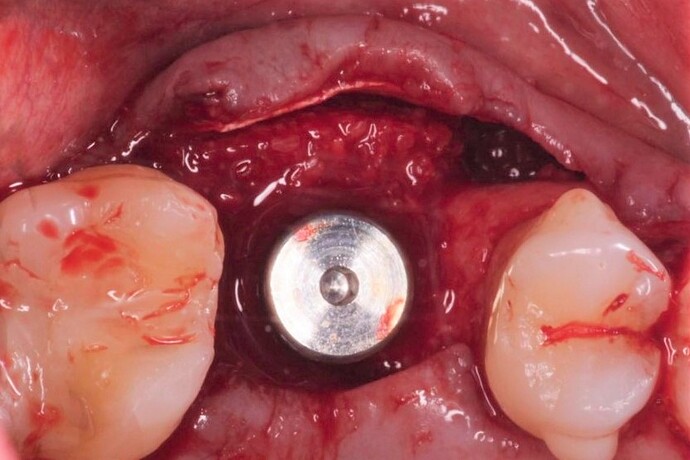When looking for vital bone regeneration around implants, I want to use a particulate allograft with strong hydrophilic properties (i.e. they draw in blood), while simultaneously allowing for a stable blood clot so that graft particles don’t get washed away. The case photos below show the use of DALI Cortical Cancellous particulate for regeneration. The DALI Cortical Cancellous particulate is a great choice for these cases, due to its ability to effectively attract blood from the surrounding bone and insure a stable clot between and around the graft particles. With this material and technique, I can be confident that vascularity around the graft will occur, so that bone precursor cells will be brought to the area and lay down vital bone.
It looks good in the second photo. I’m not really able to tell exactly what’s what in the first photo partly because I don’t have information on how you started out here, immediate placement or placement into a mature but deficient site. Was a barrier used over the graft?
Does Dali allograft attract blood and stabilize a clot differently than other particulate allografts? I use allografts from MTF , Life Net and others that seem to become well saturated with blood and later clot, but I haven’t ever considered whether they were hydrophilic or not. Are there differences among the various mineralized allografts in this property?
No, not that we are aware of. Both MTF and LifeNet are excellent and well-regarded tissue banks. There are no studies that compare the hydrophilic properties of different allografts from different tissue banks. Probably they are all similar given that the processing of allografts is very standardized now across all the major tissue banks in the US. That being said, there are some slight differences in the processing techniques at the tissue banks, that may contribute to some grafts being of higher quality than others, though this is at best anecdotal and not supported by any clinical studies.
In regards to DALI, it is processed by Surgenex, a well regarded tissue bank with a very large market share in dental. Surgenex has a patented process that it believes produces higher quality grafts. Clinicians seem to have generally liked DALI better than other allografts we have provided in the past from other tissue banks. However, that may also be based on economic considerations, because, for various reasons, the pricing on DALI is generally far better than comparable grafts, despite the equal or possibly superior quality of DALI.
Any graft with good porosity will be hydrophilic. A fully resorbing material (a mineralised allograft is not fully resorbing) will generate the most bone and would be ideal if you want maximum bone-to-implant contact. Options include autogenous bone or a beta tri calcium phosphate synthetic.
Allograft is processed to de-activate and denature the proteins of the deceased person who ‘manufactured it’
Thanks. This is semantics. Obviously, we didn’t mean to imply that the tissue bank manufactures corpses. By manufacturing, we mean processing.
Hello Osseonews. I don’t think this is semantics as they are two widely different actions. One requires full FDA approval for sale in the USA and CE mark in Europe the other does not. Kind regards Robert
We are well aware of the legal terminology and the FDA regulations, but legal terminology around tissue banks is not the topic here. I think it’s clear what we meant. But, yes, you are right: tissue banks “process”. Thanks for the clarification. We have updated the comment. Moving on…

